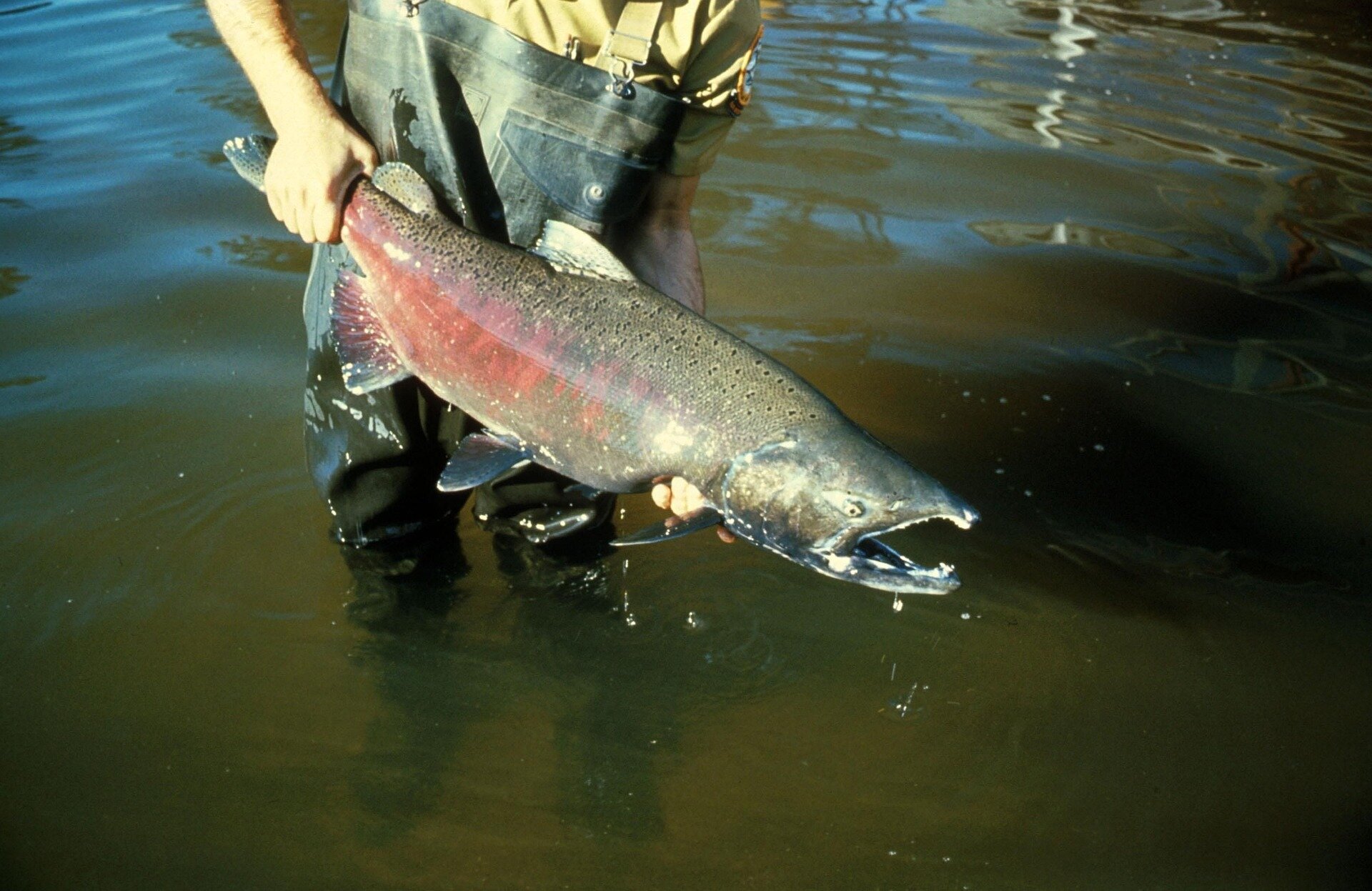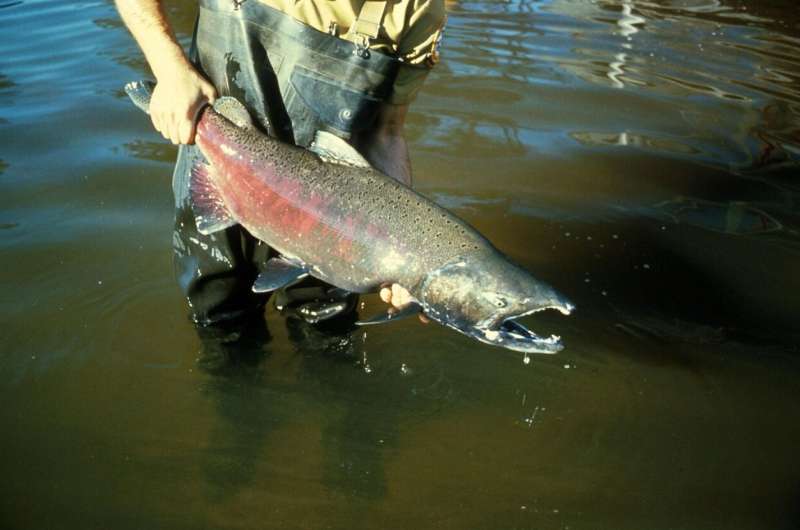

Each year, millions of Pacific salmon make a grand journey from the ocean to their freshwater spawning grounds at the end of their life cycles. This migration has rippling effects through food webs and ecosystems along the way.
Whether they decompose or are consumed by other animals, these salmon deliver both nutrients and contaminants they have accumulated in their bodies after spending most of their lives growing at sea.
A team of researchers from UConn, the University of South Dakota, the U.S. Geological Survey, Natural Resource Consultants, the University of Saskatchewan, the University of Missouri, and Regis University set out to study the transport of these nutrients and contaminants and trends as the salmon community changed over 40 years.
Their findings are published in the journal Nature.
Jess Brandt, assistant professor in UConn’s College of Agriculture, Health and Natural Resources Department of Natural Resources and the Environment and the Center for Environmental Sciences and Engineering, led the project.
The study considers the spawning migrations to North America for the five major Pacific salmon species including Chinook, chum, coho, pink, and sockeye salmon. The research team combined estimates of migrating fish biomass for the 40 years between 1976 and 2015 with Pacific salmon nutrient and contaminant tissue concentrations from scientific studies and reports.
Energy and nutrients that travel from one system to another and have positive effects are called ecological subsidies. Contaminants that move alongside nutrients that can have detrimental impacts are referred to as “the dark side of subsidies,” says Brandt.
“This research is about the ‘bright and dark sides’ of Pacific salmon subsidies. We usually study them separately in the context of transport by animals, but nutrients and contaminants go hand-in-hand.”
To start, the researchers combined the biomass estimates for each species with nutrient and contaminant concentrations to estimate the movements of these materials carried by salmon. Brandt says these movements had not been estimated at the continental scale before, and the magnitudes of materials transported by Pacific salmon were compelling.
“On average, there were an estimated 119 million Pacific salmon returning to North America each year in the 40-year period of the study. This involved the movement of thousands of tons of nutrients and kilograms of contaminants. The fluxes of nutrients by Pacific salmon we report are among the largest fluxes that have been estimated so far for large groups of animals that move materials when they emerge, migrate, or die in large numbers.”
The second question they address is how changes in the Pacific salmon community over time have impacted nutrient and contaminant transport.
They found the Pacific salmon community grew substantially over that 40-year period, both in terms of biomass and number of fish. Brandt says the estimated amount of nutrients and contaminants transported in 2015 was 30% higher than in 1976, and the increase in pink salmon biomass during this period accounted for nearly 80% of the increase they observed.
“We were curious about how shifts in the structure of the Pacific salmon community translated to changes in nutrient and contaminant transport over time,” says Brandt.
To understand the significance of these questions, it helps to look at some of the aspects of the lives of different Pacific salmon species. Brandt says that where a species feeds on the food chain (called its trophic level), how long it spends in the ocean, and how large it gets, are all important when considering contaminant concentrations.
The environmental contaminants included in this study build up in food webs and increase in concentrations from prey to predators, in a process called biomagnification. This means animals higher in the food web accumulate higher concentrations of these contaminants.
Brandt notes that contaminant concentrations in Pacific salmon are low, overall, relative to many other types of fish. Even still, there are clear differences in contaminant levels among the Pacific salmon species. Pink salmon feed lower on the food web, spend less time at sea, and are small when they return to spawning grounds.
By comparison, Chinook salmon feed higher up, spend many years in the ocean, and are the largest of the Pacific salmon species. These differences influence the amounts of contaminants each species transports.
“That’s where we started thinking about the loading potential of each species—in other words, how much of each chemical a fish carries—and how loadings of nutrients and contaminants compare. We found the higher trophic level fish, specifically Chinook salmon, will carry relatively high ratios of contaminants to nutrients. On the other hand, pink salmon carry more nutrients per contaminant.”
Despite these differences, pink salmon transported the largest overall amounts of contaminants, and this comes down to sheer numbers, says Brandt. “We also asked which species were contributing the most to nutrient and contaminant transport by the Pacific salmon community.
“Even though pink salmon have the lowest tissue concentrations of contaminants, the entire group of pink salmon contributes the greatest share of contaminants transported to North America because they dominate the community. Their numbers have increased, and even if the concentration of the contaminant hasn’t changed, if more fish are carrying the contaminant, then there’s more contaminant transferred.”
Finally, the researchers considered the tradeoffs in nutrient and contaminant co-exposure for animals that eat salmon, including people. They compared the benefits of the omega-3 fatty acids people get from eating salmon with the health risks associated with the contaminants included in the study.
“The results for each species indicated that salmon consumption brings a net benefit to people,” says Brandt. “We believe this means that there is a net benefit to the ecosystem as well.”
Studying nutrients and contaminants together gives powerful insight into the environmental impacts of migratory species like salmon.
“We miss part of the story when we study nutrients and contaminants separately. We hope this study leads to future work focused on migratory species as transporters of nutrients and contaminants and the tradeoffs between the two types of inputs for recipient systems at large spatial scales.”
More information:
Jessica Brandt, Continental-scale nutrient and contaminant delivery by Pacific salmon, Nature (2024). DOI: 10.1038/s41586-024-07980-2. www.nature.com/articles/s41586-024-07980-2
Provided by
University of Connecticut
Citation:
The bright and dark sides of Pacific salmon biotransport: Study tracks migration trends over 40 years (2024, October 9)
retrieved 9 October 2024
from https://phys.org/news/2024-10-bright-dark-sides-pacific-salmon.html
This document is subject to copyright. Apart from any fair dealing for the purpose of private study or research, no
part may be reproduced without the written permission. The content is provided for information purposes only.